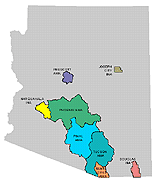
| ch. 7, pp. 90 - 92 |
Arizona’s Environmental Quality Act is designed to prevent groundwater pollution. Not federally mandated, the act is entirely an Arizona initiative, passed in response to serious groundwater pollution problems. The act called for the creation of ADEQ, to manage water and air quality and solid waste regulation. The heart of the water quality section of the law is a requirement that anyone who plans water discharges that might reach groundwater must go through the Aquifer Protection Permit (APP) process. This applies to discharges directly to watercourses as well as discharges on dry land overlying a groundwater source. The applicant must show that the discharge will not cause or contribute to a violation of Aquifer Water Quality Standards as defined by regulation. All aquifers are considered to be drinking water aquifers with drinking water standards, unless reclassified for a lesser quality. An aquifer that does not meet drinking water standards for some constituents, but meets the standards for others may have a different level of standard for each constituent. The standard is not necessarily determined at the point of discharge, but may be determined at a point underground and is influenced by existing water quality. If a standard for that groundwater has already been exceeded, the app licant must demonstrate that no further degradation will occur. Applicants must use Best Available Demonstrated Control Technology (BADCT) to obtain a permit. Certain dischargers, such as agricultural dischargers, which fit into a group sharing common characteristics, do not have to go through the full process. Instead they may be treated as part of the “General Permit” process that already has established rules. Exemptions to the APP requirements include households, stock ponds, mining overburden returned to the excavation site, water transportation systems, community sewer systems, storm water impoundments, water storage facilities and water used for public landscaping (e.g., golf courses). The law also has a permitting system for recharge and underground storage facilities. ADWR reviews such facilities for water supply concerns and ADEQ reviews the water quality matters. The applicant must meet all APP regulations except BADCT requirements. Wastewater reuse projects also go through a permitting process. Regulations are stricter when treated wastewater is to be used in areas accessible to the general public (e.g., school yards) than when used in areas that are fenced, with restricted public access (e.g., an industrial site). Edible crop irrigation with effluent is the most strictly regulated. EPA has requirements for underground storage tanks, with special emphasis on gasoline tanks. The agency also has a wellhead protection program for discharges in the vicinity of water wells. EPA also regulates hazardous waste sources and landfills and maintains the Superfund or CERCLA, which is designed to clean up hazardous waste sites. The polluter then may be charged for the cleanup. Far more sites have been identified nationally than have been cleaned up under this program. Arizona has 111 official Superfund sites, with few having been cleansed of hazardous materials. A curious feature of the Superfund program is that it exempts oil-based hazardous wastes. Arizona’s WQARF (Water Quality Assurance Revolving Fund) helps pay for clean up of polluted sites that do not meet the Superfund definition. Lack of funding has plagued the program. Wastewater and Septic Systems If wastewater is released to a surface water source, a NPDES permit is required. ADEQ requires a permit if wastewater is reused, recharged or released into a constructed wetland. County health departments, under ADEQ oversight, administer septic tank permits under state legislative rules. The federal Safe Drinking Water Act regulates the quality of water provided to consumers by water companies and municipalities. Under this act, EPA regulates public water systems, defined as those that pipe water to at least 25 people or 15 connections for at least 60 days per year. These systems may be owned by homeowner associations (e.g., Winterhaven), investor-owned water companies (e.g., Green Valley Water Company), cities and towns (e.g., Tucson Water), domestic water improvement districts (e.g., Metro Water), irrigation districts serving domestic customers (e.g., Flowing Wells Irrigation District) and others (e.g., The University of Arizona). The act does not cover smaller services or individual domestic wells. EPA sets basic standards for pollutants of concern and requires water providers to take certain measures to meet those standards. EPA is supposed to identify the potential pollutants in drinking water, study their possible health effects and set standards for the problem pollutants. The list grows as new problems are detected. New regulations adopted in 1998, for example, require water providers to control cryptosporidium, a water-borne parasite that poses a public health threat. The law requires testing at regular intervals and consumer notification if standards are not met. Although numerous violations have been recorded in recent years in the Tucson area, almost all those violations were for technical errors, such as failure to report or monitor. Almost no cases were reported of water quality standards being exceeded.
EPA recognizes that small water providers, unlike large utilities, often are unable to afford certain types of testing and treatment procedures. Variances therefore are allowed based on financial condition and the number of customers served. Smaller companies, however, must still use the best available technology within a certain price range. In addition, funding is available to assist those small companies with the greatest needs. Drinking Water Revolving Funds were created in each state to channel federal money to small water providers. EPA sets requirements for states to follow to maintain eligibility under this program
|

